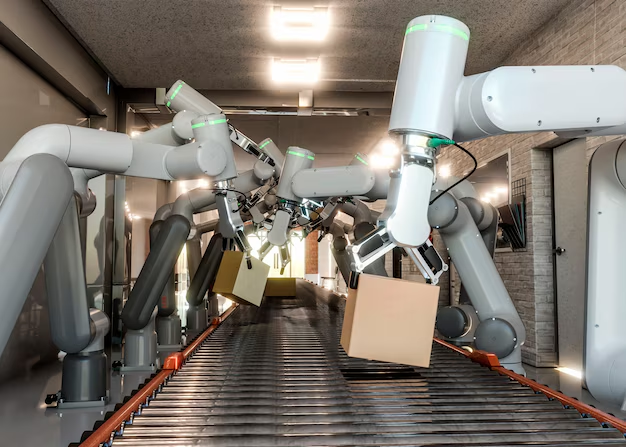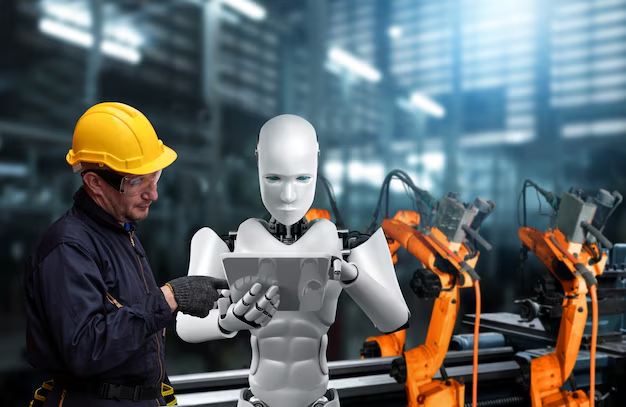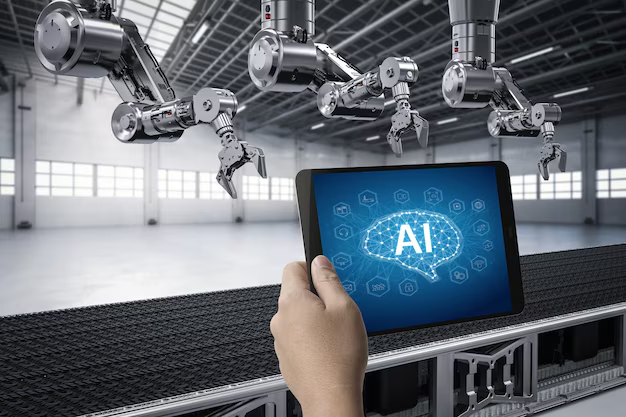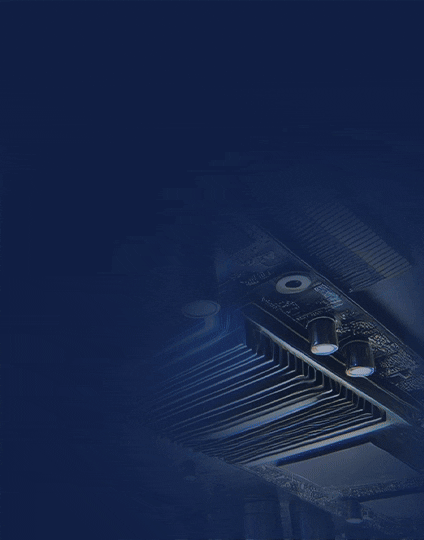Artificial Intelligence (AI) is revolutionizing the field of industrial automation by enabling autonomous robotics to perform complex tasks with precision, efficiency, and adaptability. Traditional automation relied on pre-programmed instructions, limiting flexibility and requiring human intervention for decision-making. However, AI-powered autonomous robots can learn, adapt, and respond dynamically to changes in their environment, making them indispensable in modern industries.
From manufacturing floors and warehouses to logistics and quality control, AI-driven robotics is reshaping how industries operate. These intelligent systems leverage machine learning, computer vision, and real-time data processing to enhance productivity, reduce operational costs, and improve workplace safety. As industries continue to embrace digital transformation, the integration of AI in autonomous robotics is set to play a pivotal role in the future of smart manufacturing and industrial efficiency.

AI Technologies Powering Autonomous Robotics
The effectiveness of autonomous robotics in industrial automation heavily relies on advancements in Artificial Intelligence (AI) technologies. These technologies enable robots to perceive, process, and act intelligently in dynamic industrial environments. Below are some key AI-driven innovations powering autonomous robotics:
1. Machine Learning and Deep Learning
Machine learning (ML) algorithms help robots analyze vast amounts of data, recognize patterns, and make informed decisions. Deep learning, a subset of ML, enables robots to perform complex tasks such as:
- Identifying objects in an assembly line
- Detecting product defects in quality control
- Optimizing movement patterns for efficiency
2. Computer Vision for Object Recognition and Navigation
Computer vision allows robots to “see” and interpret their surroundings using cameras and sensors. This is crucial for:
- Identifying raw materials and finished products
- Navigating factory floors and avoiding obstacles
- Performing intricate assembly tasks with precision
3. Reinforcement Learning for Adaptive Decision-Making
Reinforcement learning enables robots to improve performance through trial and error. This AI approach is used in:
- Training robotic arms to handle different materials
- Enhancing warehouse robots’ picking and sorting efficiency
- Optimizing robotic movements to reduce energy consumption
4. Natural Language Processing (NLP) for Human-Robot Interaction
With NLP, robots can understand and respond to human commands, making collaboration easier in industrial settings. Applications include:
- Voice-controlled robots in smart factories
- AI chatbots guiding technicians in maintenance tasks
- Human-robot collaboration for efficient workflows
5. Edge AI for Real-Time Processing in Industrial Environments
Edge AI enables robots to process data locally, reducing reliance on cloud computing. This ensures:
- Faster decision-making with minimal latency
- Enhanced security by reducing data transmission risks
- Greater autonomy in mission-critical applications
By integrating these AI technologies, autonomous robots are becoming more intelligent, efficient, and adaptable, driving the next wave of industrial automation.

Applications of AI in Autonomous Industrial Robotics
AI-powered autonomous robots are transforming industrial automation by enhancing productivity, precision, and adaptability across various sectors. These robots perform tasks with minimal human intervention, optimizing efficiency and reducing operational costs. Here are some of the key applications of AI in industrial robotics:
1. Manufacturing & Assembly
AI-driven robotic arms and collaborative robots (cobots) are revolutionizing manufacturing by:
- Automating repetitive tasks such as welding, painting, and assembling components
- Enhancing speed and accuracy in high-volume production lines
- Reducing human error and minimizing defects in finished products
2. Warehouse Automation
AI-powered robots in warehouses streamline logistics operations by:
- Using computer vision and ML to sort, pick, and pack items
- Optimizing inventory management with real-time data processing
- Navigating autonomously in dynamic environments to transport goods
3. Quality Control & Inspection
AI-based visual inspection systems improve product quality by:
- Detecting minute defects in manufactured products using computer vision
- Performing non-destructive testing (NDT) with high accuracy
- Ensuring compliance with industry standards and reducing waste
4. Predictive Maintenance
AI-powered predictive analytics help industries prevent equipment failures by:
- Monitoring machine performance through IoT sensors
- Identifying anomalies and predicting potential breakdowns
- Reducing downtime and extending the lifespan of industrial equipment
5. Logistics & Material Handling
Autonomous Guided Vehicles (AGVs) and mobile robots enhance material handling by:
- Transporting raw materials and finished goods within factories
- Reducing the need for manual labor in high-risk environments
- Optimizing supply chain workflows with AI-powered route planning
6. Collaborative Robotics (Cobots)
AI-driven cobots work alongside human workers to:
- Assist in complex tasks requiring precision and adaptability
- Improve workplace safety by reducing strain from manual labor
- Enhance production efficiency through human-robot collaboration

Benefits of AI in Industrial Automation
The integration of Artificial Intelligence (AI) in autonomous robotics has significantly transformed industrial automation, offering numerous advantages. From increased efficiency to improved safety, AI-powered robots are reshaping modern industries. Below are some key benefits:
1. Increased Efficiency and Productivity
- AI-driven robots work continuously without fatigue, boosting production rates.
- Machine learning algorithms optimize workflows, reducing cycle times.
- Automated systems handle repetitive tasks, allowing human workers to focus on complex problem-solving.
2. Reduced Operational Costs
- AI enables predictive maintenance, preventing costly equipment failures.
- Automation minimizes material waste and enhances resource utilization.
- Energy-efficient robotic systems reduce overall power consumption.
3. Enhanced Accuracy and Quality Assurance
- Computer vision and AI-driven inspection detect defects with high precision.
- AI-powered robots maintain consistent quality in manufacturing processes.
- Reducing human error ensures higher product reliability and compliance with standards.
4. Improved Worker Safety
- AI-powered collaborative robots (cobots) handle hazardous tasks, reducing workplace injuries.
- Robots can operate in extreme conditions, such as high temperatures or toxic environments.
- AI-driven safety protocols prevent accidents and optimize risk management.
5. Real-Time Adaptability and Decision-Making
- AI enables robots to learn and adjust to changing production demands.
- Reinforcement learning helps machines improve their performance over time.
- Edge AI allows real-time data processing, ensuring faster decision-making in industrial environments.
6. Optimized Supply Chain and Logistics
- AI-powered autonomous guided vehicles (AGVs) streamline material handling and warehouse operations.
- Smart inventory management reduces stock shortages and overstocking.
- AI-driven logistics improve route planning and delivery efficiency.
7. Scalability and Future Readiness
- AI-driven robotics can be easily scaled up or down based on industry demands.
- The integration of Industry 4.0 technologies, such as IoT and digital twins, enhances future adaptability.
- AI continuously evolves, ensuring long-term industrial competitiveness.
By leveraging AI in industrial automation, businesses can enhance efficiency, reduce costs, improve quality, and ensure a safer working environment, making it a game-changer for modern industries.

Conclusion
The integration of AI in autonomous robotics is revolutionizing industrial automation by enabling smarter, more efficient, and highly adaptive systems. AI-powered robots are not only streamlining manufacturing, logistics, and quality control but are also enhancing workplace safety and reducing operational costs. With capabilities such as machine learning, computer vision, and real-time decision-making, these intelligent systems are driving industries toward greater precision, scalability, and sustainability.
Despite challenges like high implementation costs and cybersecurity concerns, the future of AI-driven robotics remains promising. As advancements in AI, IoT, and automation technologies continue, industries will witness even greater levels of efficiency and innovation. Embracing AI-powered robotics is no longer just an option but a necessity for industries looking to stay competitive in the era of Industry 4.0 and beyond.












